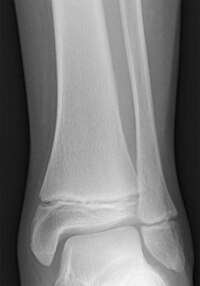
Photo from wikipedia
OBJECTIVE The process of longitudinal bone growth occurs at the growth plate where the chondrocytes undergo apparent structural and molecular changes to promote growth. Recent reports suggest that radial shockwave… Click to show full abstract
OBJECTIVE The process of longitudinal bone growth occurs at the growth plate where the chondrocytes undergo apparent structural and molecular changes to promote growth. Recent reports suggest that radial shockwave treatment (rSWT) stimulates bone length in cultured fetal rat metatarsals. Therefore, we investigated if rSWT has similar growth promoting effects on cultured human growth plate fragments and addressed the same in a preclinical in vivo rabbit model by subjecting their growth plates to rSWT. METHODS Short-term effects of high-energy rSWT were evaluated in a unique model of cultured human growth plate cartilage (n = 5) wherein samples exposed to rSWT were assessed for chondrogenic markers at 24 hours in comparison to unexposed samples obtained from the same limb. Local in vivo effects were studied in six-week-old rabbits who had their distal femurs exposed to four weekly sessions of rSWT at low- and high-energy levels (n=4 each). At sacrifice, histomorphometric and immunohistochemistry analyses were performed. For effect on longitudinal growth, proximal tibiae of 22-week-old rabbits (n=12) were asymmetrically exposed to rSWT; the contralateral side served as untreated controls. At sacrifice, the final bone length was measured. RESULTS In the ex vivo model of cultured human growth plate cartilage, rSWT exposure upregulated SOX9 and COL2A1 compared to control. In the immature rabbit model, an increased number of proliferative chondrocytes and column density was seen for both the energy levels. In the adolescent rabbits, an increase in tibial length was observed after the fourth session of high-energy rSWT and until six-weeks after rSWT compared to the untreated limb. CONCLUSIONS Our preliminary experimental results suggest that rSWT may serve as a non-invasive treatment and possibly a safe strategy to stimulate longitudinal bone growth. However, further studies are needed to assess the in vivo effects of rSWT in models of disturbed bone growth.
Journal Title: Bone
Year Published: 2021
Link to full text (if available)
Share on Social Media: Sign Up to like & get
recommendations!